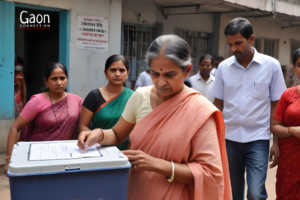Scientists from CSIR-Central Mechanical Engineering Research Institute (CMERI), Durgapur in West Bengal have developed a retractable-roof polyhouse that will enable farmers to open or shut the roof of the polyhouse as per the requirement.
“Till recently, we had only the ‘naturally ventilated’ polyhouses. But this one with the retractable roof will help farmers control the temperature and growing environment of the crops,” Jagdeesh Manik Rao, senior scientist CSIR-CMERI, told Gaon Connection. “For example when it rains and the particular crop needs the rain, the farmers can open up the roof and allow the rain in. If the crop needs to be protected from rain, the roof can be covered. It is the same with sunlight,” he explained.
Also Read: Portable polyhouse puts the smile back on faces of marginal farmers in the hills
A model of the polyhouse with a retractable centre will be set up in Ludhiana, Punjab at CMERI extension centre. The foundation stone for it was laid on July 31, by Harish Hirani, director, CSIR-CMERI. He also inaugurated a naturally ventilated polyhouse facility there.
CSIR-Institute of Himalayan Bioresource Technology (IHBT) based in Palampur, HImachal Pradesh is also associated with the development of the retractable-roof polyhouse.
The retractable roof works automatically. “We are installing sensors to gauge rain, carbon dioxide, humidity and temperature. The polyhouse will create the right environment for the crops,” Rao explained. These retractable-roof polyhouses will do away with the need of extra blowers, ventilation vents, etc.
Twin design polyhouse
There are two kinds of retractable-roof polyhouses. One, where the roof can be opened and closed manually by the farmer, and the other where it is automatic. “The manually operated retractable roof polyhouses are priced at thousand rupees a square metre while the fully automatic ones cost fifteen hundred rupees a square metre,” Rao said.
In order to study the pros and cons of the retractable roof polyhouse when compared to the naturally ventilated polyhouse, CSIR-CMERI scientists will be observing and recording the findings at Ludhiana’s extension. Both kinds of polyhouses are set up there where horticultural crops are growing.
“Farmers in our country sometimes face extreme weather conditions, such as heat, cold, rain…They also have to contend with pests which destroy about fifteen per cent of our crops,” Hirani told Gaon Connection.
Tracking climate change
Polyhouses are sensitive to the environment and can protect the crops to quite an extent, Hirani said. The traditional polyhouses with a fixed roof have the disadvantage that because the area underneath is always covered, the temperature of the soil can go up and there can be insufficient sunlight for the plants.
This can be adjusted with the polyhouses with the retractable roofs, Hirani pointed out. These polyhouses would to a large extent control the growing environment of the crops, especially in the face of climate change, he added.
Also Read: Healthy Returns: Vegetable and fruit cultivation picks up momentum in India
“The technology used in the retractable-roof polyhouses will enable the farmers to get the updates on the weather conditions, what the crops need in terms of humidity, temperature, moisture, etc.,” the director of CSIR-CMERI said. “This way it will help the farmer cultivate both seasonal and nonseasonal crops,” he explained.
Scientists in Ludhiana will be testing both kinds of polyhouses and they hope to make this technology ready for the farmers to use in six months’ time.
Read the story in Hindi.


















